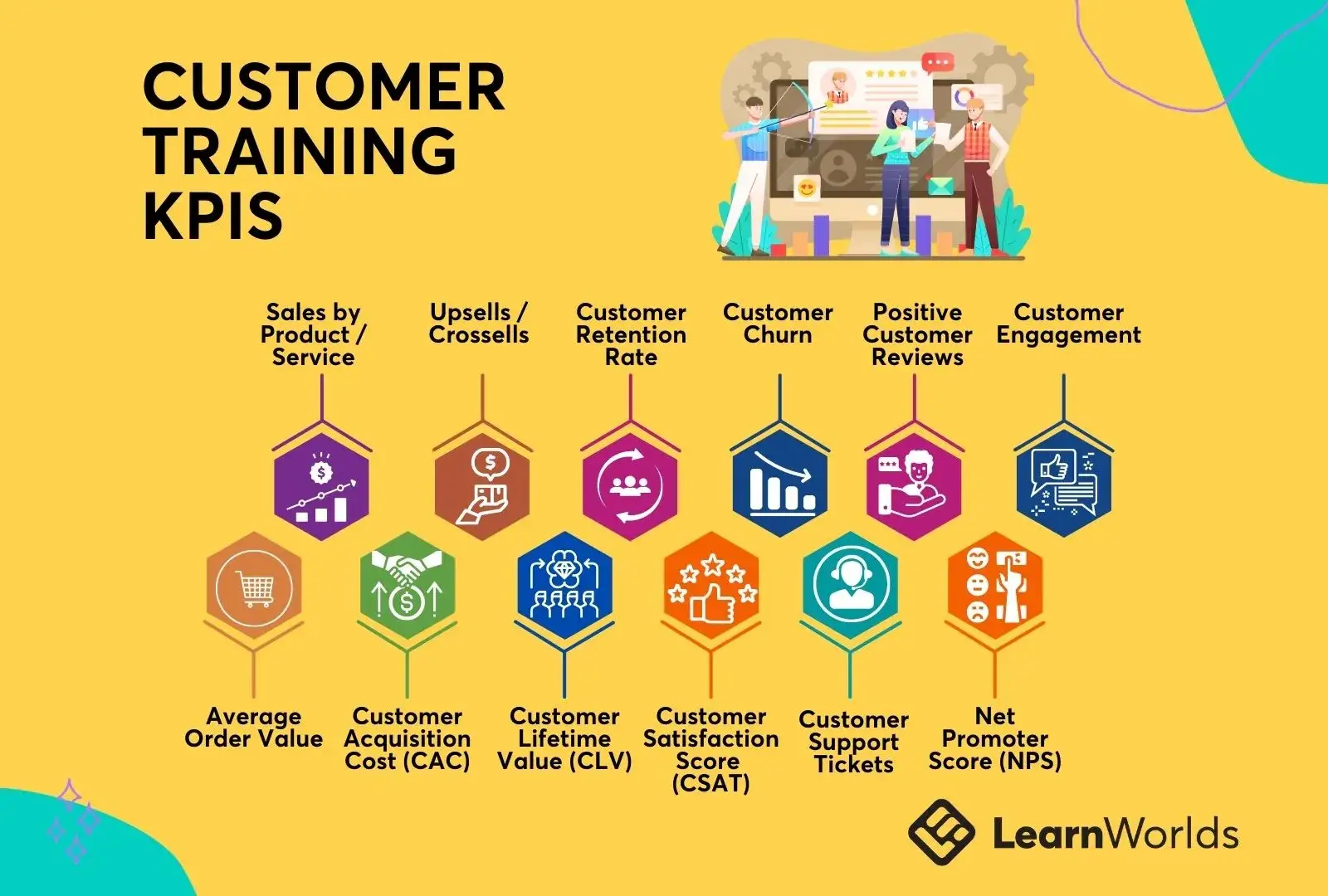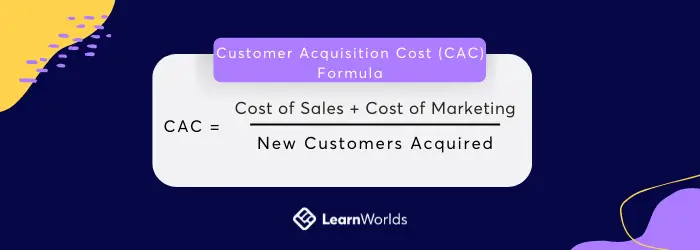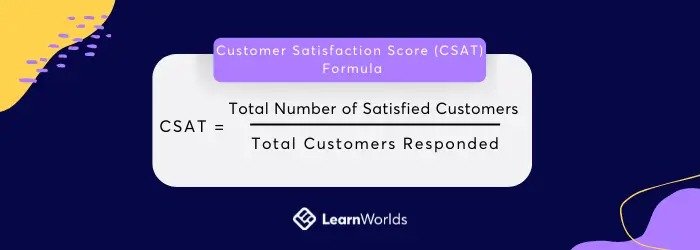Table of Contents
All companies, big or small, need to set business goals and develop a strategy for reaching them. They also need to have a system in place for evaluating their progress against these goals.
Similarly, when you deploy training, whether it’s employee training or a customer education program, you need to evaluate whether it has brought the desired business results.
In the case of customer training, Key Performance Indicators (KPIs) provide a reliable evaluation system that can measure its impact on your business.
In this post, you’ll find out what customer training KPIs are, the most important KPIs to measure, and how to identify them. We’ll also go over other factors you need to consider when evaluating the effectiveness of customer training and a couple of ways to keep track of them.

What are Customer Training KPIs?
Key Performance Indicators, in general, are measurable values that indicate how a company is performing in a goal they’ve set. Companies need to implement a method for tracking KPIs regularly, as this will help them see where they stand in terms of their goals and identify areas they can improve in.
All KPIs fall under one of these two broad categories:
KPIs can be categorized further down based on the business area they’re focusing on, for example:
Depending on your goals, you need to measure different KPIs. Customer training KPIs indicate whether a customer training program has achieved your expected business results.
Using Customer Training Goals to Identify your KPIs
We could just continue with a list of important KPIs to measure customer training effectiveness. But, we thought it best to start with the rationale behind it.
To decide the best metrics to measure, you need to circle back to the reasons why you deployed the program in the first place. What were the goals you were trying to achieve?
Next, you need to define the best metrics to measure each one of these areas. And these are your customer training KPIs!
12 Important Customer Training KPIs to Measure
Here’s a list of the 12 top KPIs to measure the success of your online training program. These KPIs aim to measure the effectiveness of customer education in terms of business results.
We haven’t included more generic, financial KPIs, like revenue and net profit, as these are more complicated and are the result of multiple factors.
1Sales by Product/Service
An all-time-favorite metric is sales (because numbers don’t lie). If you’ve created a training program to educate customers on a new product or service and the number of sales is up, that’s a sign of success! It means that word has gotten out and more people are aware of the value of your product.
2Average Order Value
How much are customers spending each time they buy from you? The average order value can significantly increase your revenue even if the number of people who buy your products doesn’t increase. Average order value usually goes hand in hand with the metric that follows.
3Upsells and Cross-Sells
“Would you like some Coke with your fries?” is a typical example of cross-selling. If you sell cell phones and customers have started to buy headphones, screen protectors, and other accessories, that’s another example of cross-selling.
“Would you like a large Coke instead of a medium for an additional $0,50?” … and that’s upselling! Upselling is when a customer buys a more sophisticated and usually more expensive version of the product they originally set out to buy. Signing up for a premium instead of a basic plan perfectly describes an upsell.
Customer training helps with upselling and cross-selling because it boosts overall engagement with your products. Clients who have already bought an online course from you and made good use of it are more likely to try other online courses or digital products you’re selling, with minimum effort from your salespeople.
4Customer Acquisition Cost (CAC)
Customer Acquisition Cost (CAC) refers to the amount of money a company spends to acquire a new customer. This includes everything from marketing campaigns to employee salaries. Customer acquisition is an expensive sport regardless of the industry you’re in. This is why all business owners should be passionate “customer retention” fans, which comes at a significantly lower cost.
A decline in CAC can be attributed to customer training. Over time, a customer training program helps you build a strong brand and good reputation, which means that less money will need to go into marketing to draw new customers in.

5Customer Lifetime Value (CLV)
Customer Lifetime Value is the average revenue generated from a customer over their relationship with a company – or simply put, while they remain your customers. Customer Lifetime Value and Customer Acquisition Cost usually go hand in hand, as comparing one against the other help you predict profitability.
Customer training helps customers learn, enjoy, and engage with your product. Eventually, they will start buying more products from you, which will result in an increase in the Customer Lifetime Value.
6Customer Satisfaction Score (CSAT)
This qualitative metric is one of the biggest challenges for all businesses – keeping their clients happy. Customer training helps increase customer satisfaction in multiple ways.
Customers who know the products better and integrate them into their lives, feel more connected with your brand, they trust you more, and they can even resolve minor issues on their own! How can they not be happy?

7Customer Retention Rate
Another challenge and another crucial metric is customer retention. You can easily understand why businesses of all kinds and sizes go to extra lengths to keep their customers – it’s vital for their survival! As we discussed before, retaining a client is a lot cheaper than acquiring a new one.
Moreover, loyal customers spend more than first-time or occasional customers and are also excellent brand ambassadors, leaving positive reviews online or bringing new clients your way through word of mouth advertising.
Customer retention is closely linked to customer satisfaction. Consequently, since customer education increases customer satisfaction, customer retention rates will also rise.
8Customer Churn
It almost hurts your mouth to say customer churn, and it definitely hurts a business to see this metric increase. Customer churn refers to the number of clients lost. Businesses should strive for a churn rate as close to 0% as possible. In the long run, a customer training program should help decrease this number by improving a customer’s relationship with your brand.
9Customer Support Tickets
Let’s not forget that the primary goal of customer training is to educate customers on how to use a product or service. Having done that successfully, businesses should see a decrease in the number of support tickets, as now clients have access to resources that answer their questions and can use the product with more confidence.
10Positive Customer Reviews
Happy clients become brand ambassadors who want to thank a business publicly for improving their lives and spread the word about the awesome product or service they have put in use. If positive customer reviews are on the rise, then your customer training program is doing its job.
11Net Promoter Score (NPS)
“On a scale from 1 to 10, how likely are you to recommend our product to a friend or colleague?” This single question gauges customer satisfaction and enthusiasm and generates the Net Promoter Score.
NPS is important because it can predict future growth. That said, you shouldn’t over-rely on NPS but rather use it in tandem with more in-depth surveys.
12Customer Engagement
Do customers like your posts and stories? Do they share advice about your product in your social media groups? Are they leaving reviews? These are all examples of an engaged customer. Customer engagement refers to any meaningful interaction between a customer and a company.
Customer engagement is a more complicated metric than it originally seems. To get a better idea of how engaged your customers are, you need to look into most of the different metrics we’ve seen today.
How to Track Customer Training KPIs
There are two ways to keep track of your KPIs:
4 Factors to Consider When Measuring Customer Training Effectiveness
Sometimes a surge or a decline in the above KPIs has nothing to do with customer training. Other times, it does. How can you tell?
See below a list of factors all training managers need to consider when measuring the effectiveness of customer training:
Changes in the Market
Changes in the market or your industry may play a role in shaping your business KPIs. Especially if you’re not happy with them, consider the following:
Changes in Your Business Strategy
Let’s say your KPIs are currently hitting the roof. Customer training must have played a part in this, but think about what else you’ve been doing differently lately, so you keep it on as well.
Have you made some great new hires in your product team? Have you shifted your social media strategy? Take into consideration every change you’ve implemented and measure employee performance metrics too because your workforce plays a pivotal role in growth too.
Evaluate the Training Program Itself
It’s important to evaluate your customer education initiatives post-training by looking into learning KPIs. In fact, training metrics are the first thing you need to monitor to get a first taste of whether customers have enjoyed and benefited from your program.
Knowing whether your training courses have engaged learners will help you improve your training efforts and steer them in the right direction. So, here’s how to do it:
Give it Time
It takes time to see results after training initiatives. If you measure your KPIs two months after deploying your training program, you’ll only get disappointed. Most business metrics take significant time to improve. While there might be an immediate surge in positive reviews and NPS, it may take time before customer satisfaction and retention improve or before your brand becomes more popular.
Help Your Customers be Always Right
Showing customers how to make good use of your product has amazing business benefits. To reap these benefits, though, you need to build a top-notch online academy with engaging content, diverse resources, and opportunities for social learning. You also need extensive analytics to measure your learning and development KPIs.
LearnWorlds helps you build interactive and engaging learning experiences on your very own online academy with additional features you’ll love:
Further reading you might find interesting:

Androniki Koumadoraki
Androniki is a Content Writer at LearnWorlds sharing Instructional Design and marketing tips. With solid experience in B2B writing and technical translation, she is passionate about learning and spreading knowledge. She is also an aspiring yogi, a book nerd, and a talented transponster.

